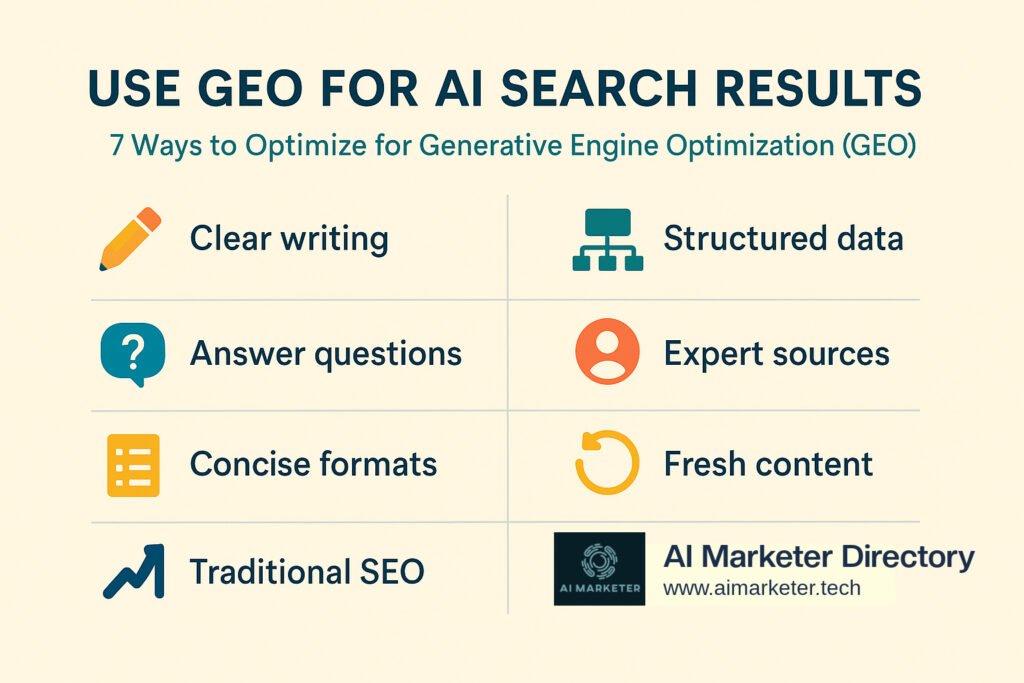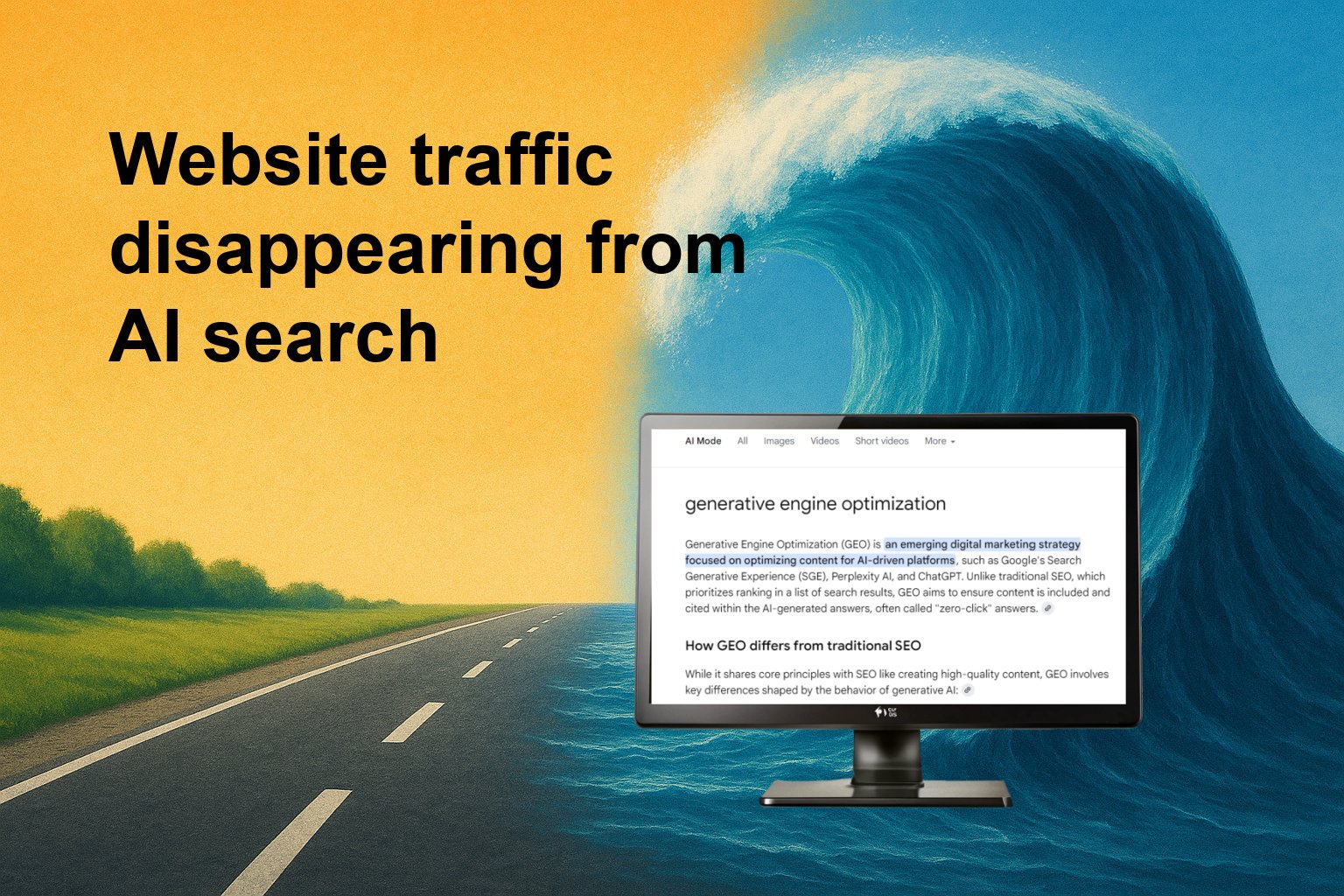Search isn’t what it used to be. In just one year, AI summaries have nearly cut website traffic in half. When Google adds an AI Overview to a results page, users click on traditional links only 8% of the time – compared to 15% without the AI box, according to Pew Research. That’s a 50% drop.
For marketers, this shift is seismic. The old SEO playbook of keywords and backlinks isn’t enough anymore. With AI-powered search engines rewriting the rules, the path forward is Generative Engine Optimization (GEO). Here’s a comprehensive look at what marketers must do now.
AI Search Changes Everything
Instead of just showing a list of links, AI now summarizes, answers, and even recommends, sometimes without sending people to your website at all.
“AI Overviews are reshaping the search landscape in real time, and marketers can no longer rely on rankings alone. Visibility now means earning a spot in the answer itself,” says Eugene Levin, President at Semrush.

AI search summaries are a search engine tsunami. In March 2025, 13.14% of all US desktop Google queries triggered an AI Overview, up from 6.49% in January 2025, according to Semrush.
In pages with an AI summary, users clicked on traditional search result links in just 8% of visits. With no AI summary, clicks were about 15% of visits according to the Pew Research Center. Many publishers say the introduction of AI summaries last year hit Website traffic hard. This reduction of nearly 50% shows that impact.
If you’ve been relying on old-school SEO tactics, it’s time to think differently. Welcome to Generative Engine Optimization (GEO).
What’s Changed With AI in Search
Here’s a quick rundown of how AI summaries have hit search results and click-throughs hardest:
- Answers on the page, not clicks. AI often gives users a complete answer right in the search result, which means fewer people may click through to your site.
- Sources matter. AI models need trusted references. They pull from high-quality, well-structured content to build their answers.
- Context over keywords. No more keyword stuffing. It’s all about the correct phrase and clearly answering the intent behind a search query.
- Content visibility is fragmented. With search results now blending websites, AI answers, and other formats, you need to optimize for multiple surfaces – not just the classic “10 blue links.”
What Is GEO?
Generative Engine Optimization (GEO) is about making your content easy for AI-driven search engines to find, understand, and cite in their results. Think of it as SEO 2.0. Still about visibility, but now aimed at being chosen as the source behind an AI answer.
Simple GEO Tactics You Can Start Using
“While AI will radically change consumer search behavior over the next few years, it’s relying on a lot of the same signals Google’s been rewarding for over a decade. Brands need unified content and authority-building strategies that drive brand visibility across the multiple platforms where your target market resides,” writes Kelsey Libert in the Search Engine Land blog.
In fact, 82% find AI-powered search more helpful than traditional SERPs. The problem is 26% don’t click through from Google AI summaries to a website. That’s compared to 16% who don’t click through from traditional search results.

Here are seven GEO tactics that can help get you into key LLM search summaries:
Write for clarity, not cleverness.
AI models reward content that directly answers questions. Use plain, clear language. Break complex topics into easy-to-digest sections.
Use structured data.
Schema markup helps AI understand what your page is about. Adding structured data increases your odds of being cited in generative answers.
Answer specific questions.
Think of your content as a Q&A resource. Use headers like “What is…?” or “How do I…?” and then answer directly.
Build authority with sources.
Cite reputable studies, stats, and industry experts. AI looks for trustworthy signals, and references help establish you as a credible source.
Optimize for snippets, not just rankings.
Concise, well-formatted answers (lists, tables, step-by-steps) often get picked up in AI-generated results.
Keep updating your content.
AI engines prefer fresh, relevant information. Outdated blog posts or guides are less likely to surface.
Don’t ignore traditional SEO.
GEO doesn’t replace SEO. You still need fast-loading pages, strong internal linking, and keyword research. GEO builds on those foundations.
Why GEO Matters
Marketers who adapt early will win visibility in the new search landscape. Those who don’t risk fading away as AI engines skip over stale, unclear, or unstructured content.
GEO isn’t about gaming the system. It’s about making your content easier for both people and LLMs to find and trust.
Final thoughts
Search is no longer about showing up on page one. With AI, it’s about showing up inside the answer. The winners will be those who adapt their content for GEO—clear, structured, and trustworthy enough to be cited by generative engines. The question isn’t whether GEO matters. It’s how fast you move. Start testing, updating, and optimizing now, because AI search isn’t waiting for you.
Top 9 SEO & GEO Tools

Here’s a list of our nine top-rated AI SEO and GEO tools from our AI Marketer Directory. We particularly like Geordy, Knowatoa and Goodie for their free trial, reasonable entry-level pricing, how-to resources, and friendly dashboards. LPagery’s AI rank tracker is full-featured and well-priced. But any of these GEO tools will give you ways to rank in AI search results.
Click on any of these tools to get key features, pricing and user ratings. And, good luck in using GEO to enhance your content and AI search results on the leading LLMs.
Athena – Athena offers a Generative Engine Optimization (GEO) platform that helps brands track, measure, and shape their presence in AI searches.
Geordy – Geordy turns any URL into AI-ready content fast, automating structured formats so your site is more visible and understood by models like ChatGPT, Claude and Perplexity.
Goodie – Goodie’s suite of tools helps brands enhance their visibility across AI answer engines like ChatGPT, Gemini, and Perplexity.
Kai – Kai shows how you appear in AI-driven search and question‑answering systems like ChatGPT, Perplexity, etc, with reports on visibility, perceptions, factual accuracy, and how you compare to competitors for key topics.
Knowatoa – This is our favorite platform for its excellent dashboard, GEO basics, ease-of-use, reasonable pricing and free trial.
LPagery AI Rank Tracker – Lets marketers see whether ChatGPT, Gemini, Claude, and other chatbots actually mention your business for target keywords.
Otterly – monitors brand mentions, citations, share of voice, and sentiment across multiple LLMs. Users can audit on-page content for GEO with over 25 visibility checks.
Peec AI – Tracks, analyzes and improves brand performance on AI search platforms with metrics including visibility, positioning and sentiment analysis.
Scrunch AI – Scrunch AI helps brands understand and shape how AI agents — like chatbots, answer engines, and virtual assistants — represent them. It offers three main tools: Monitoring, Insights & AXP.
By Jeff Domansky, Managing Editor, AI Marketer Tools Directory











